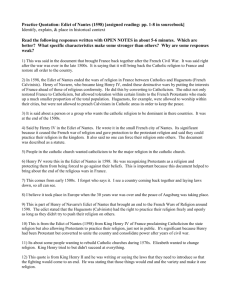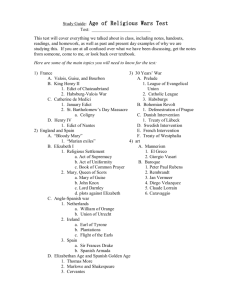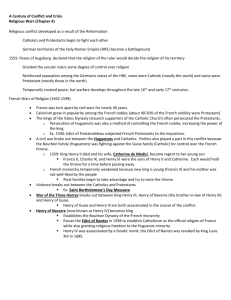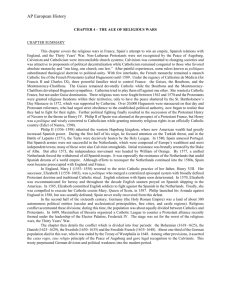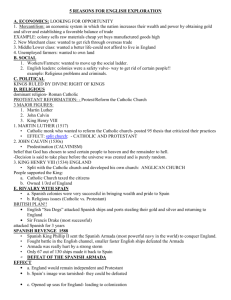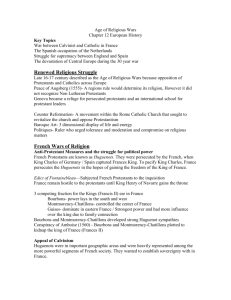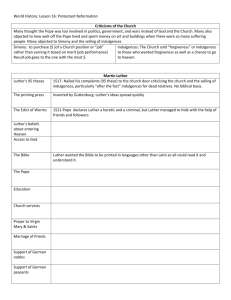THE WAR
advertisement
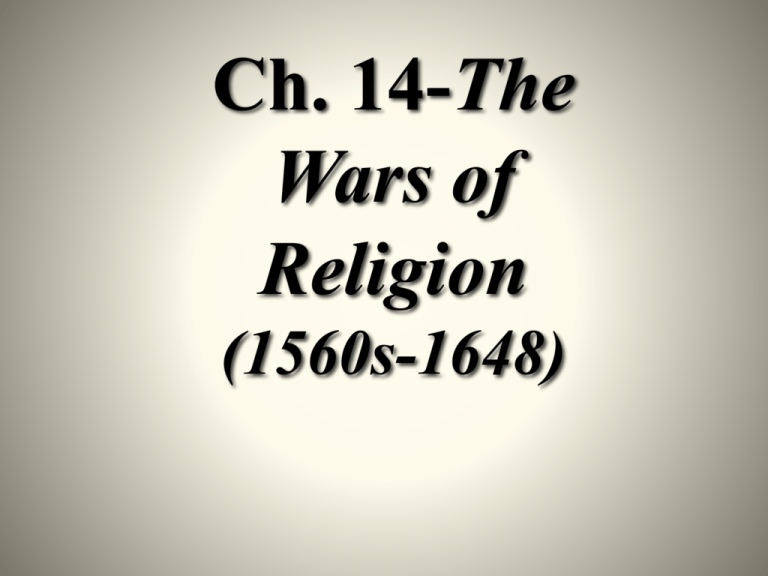
Ch. 14-The Wars of Religion (1560s-1648) #13 & 14. Habsburg-Valois Wars • A series of conflicts from 1494 to 1559 between the leading European powers for control of the Italian states. The wars involved most of the Italian states, the papacy, Spain, the Holy Roman Empire, France, and Switzerland. Principally, the conflict was between France and Spain, with the changing allegiance of the rival Italian states and of the pope being determined by their own immediate interests. The final outcome was the victory of Spain. Culturally, the wars were significant for spreading the influence of the Italian Renaissance throughout Europe. #13 & 14-Habsburgs…Valois • Habsburgs: Ruling house of Austria 1282-1918!! • Valois: Royal house of France from 1328-1589 #15. Concordat of Bologna • between King Francis I (France) of France & Pope Leo X • Francis I agree to recognize the supremacy of the papacy over a universal council. Crown gained the right to appoint all Fr. Bishops & abbots. • Crown would decide who would lead the Church a victory for the Monarchy • Catholic Church in France was known as the Gallican Church. noblesse de robe, (French: “Nobility of the Robe”) • 17th- and 18th-century France, a class of hereditary nobles who acquired their rank through holding a high state office. Their name was derived from the robes worn by officials---------- • nobles who derived their rank from military service (noblesse d’épée) Civil War In France (1562-1598) The Valois Family: The Beginning of the End Henry II (ruled 1547-59) was the last powerful Valois. Married to Catherine de Medici Three weak sons followed: Francis II(r. 1559-60) Charles IX(r. 1560-74) Henry III(r. 1574-89) Catherine de Medici controlled the sons: Was mother to the boys Played both sides in the civil war Developed a reputation for cruelty Catherine de Medici Bon in Florence, Italy. The daughter of Lorenzo II, grandson of Lorenzo the Magnificent! Catherine de Médici: • Very important political figure in the French Wars of Religion. • When King Francis II died, she became the regent for her underage son and assumed temporary power over France. • Her main goal was to keep her son on the throne and to keep the monarchy alive. • Suffered a failed attempt at reconciling the two factions of Protestants and Catholics. • In 1562, she allied herself with the Protestants, giving them rights to worship publicly outside of towns and privately within them in the January Edict. • This edict was followed by three periods of conflict known as the French Wars of Religion. The French Civil War There were two sides: Guise family led Catholics in North Bourbon family led Huguenots in South Fighting for the royal inheritance #16.Huguenots:A name by which the French Protestants are often designated. Its etymology is uncertain. Catherine supported the Guises in the first phase. #17. St. Bartholomew’s Day Massacre August 24, 1572 20,000 Huguenots were killed Henri of Navarre, a Bourbon, survived St. Bartholomew’s Day Massacre #18. War of Three Henry’s 1584-89; eighth and final conflict in the series of civil wars in France known as the Wars of Religion..resulted from the St. Bartholomew’s day massacre • Henry III • 1574-89 • 4th son of Henry II & Catherine de Medici • Leader of the royal army in the Fr. Wars of Religions vs. Huguenots • Assassinated! Henry III 2nd Henry: Henry: 3rd Duke of Guise • Duc de Guise: title of nobility • Leader of the Catholic faction who formed the Catholic League in 1576 to keep the new heir, Henry of Navarre off the throne • Assassinated! The Catholic League • A radical Catholic group formed by Henry of Guise in 1576. • They fought for unity under Catholicism in France, and forced Henry III to pursue their goal. • They took power in Paris in the 1580’s, and the King was forced out after a failed attack on the League. • They were dispersed in 1596, after Henry IV took the throne, and the people were too tired of religious war. 3rd Henry-Henry IV(Navarre) • Henry Bourbon • Protestant: led the Huguenot forces • Winner(by default)! Becomes the 1st Bourbon monarch of France • #9. “Paris is worth a mass” • Converts to Catholicism in effort to unify the country, but gives Huguenots freedom of worship! The French Civil War Catherine started supporting the Bourbons. Catholic League CIVIL WAR Protestant Union Henri of Navarre defeated Catholic League & becomes Henry IV(Bourbon) of France. Effects of Civil War: France was left divided by religion Royal power had weakened Valois family now replaced by Bourbons Triumphal Entry of Henry IV Into Paris – Peter Paul Reubens Henry IV of France Ended Spanish interference in France Converted to Catholicism : Did this to compromise and make peace Paris is worth a mass. This was an example of politique(#19) [the interest of the state comes first before any religious considerations] Passed Edict of Nantes(#8) in 1598: Granted religious rights to Huguenots Did not grant religious freedom for all (#20)The Edict of Nantes-1598 • April 13, 1598, Henry IV made a formal religious settlement and instated the Edict of Nantes. • According to this edict, while Catholicism was to remain the official religion of the country, minority religions were given religious tolerance. • It did not end the conflict between the religions but it stopped open warfare between the opposing powers. • However, as significant as this edict was, it would only transform the long hot war between the Catholics and the Huguenots into a long cold war. • Henry IV was assassinated in 1610 by a Catholic fanatic. The Fall of the Edict of Nantes • Edict of Nantes subdued religious warfare. • Henry’s political and economic policies laid the foundations for a new France. • Stability within the region remained until the rise to power of Louis XIV. • Revoked(by Louis XIV) the Edict of Nantes in 1685 and sent France back into a state of religious turmoil. Dutch War of Independence 1568 - 1648 Phillip II Historical Background • Spain becomes world power • Netherlands(#22) was the richest area in all of Europe (center of trade) • Charles V had inherited the 17 provinces that compose modern-day Belgium & the Netherlands (provinces were self governing). MAJOR CAUSES • Emperor Charles V was succeeded by his two sons Philip II (Spain and Netherlands) and Ferdinand (Austria, Hungary, imperial title.) • Church Reform of the Netherlands (Catholicism – Calvinism/Protestantism) • Location-The Netherlands were extremely far away from their central government located in Spain. • The spread of Calvinism encouraged opposition to ungodly political authorities & led to a wave of iconoclasm THE WAR: The Duke of Alva-Fernando Alvarez de Toledo • The Duke was a regent of Philip II. • Spanish general & governor of the Sp. Netherlands • Sent to the Netherlands to persecute Protestants. • Started the Council of Troubles (#12)Council of Blood) • Know as the “Iron Duke” • 1st example of “Black Legend”-depiction of Spanish as blood thirsty, cruel, greedy, & fanatical • Imposed the Spanish alcabala (tenth penny). THE WAR: PHILIP VS. WILLIAM PHILIP II • • • • King of Spain Hard Core Catholic Conformity and unification Control over Netherlands WILLIAM OF ORANGE • Leader of Netherlands opposition • Catholic, Lutheran, and Calvinist • Independence from Spain • Will be assassinated! THE WAR: Spain Loses Power • William of Orange came out of exile to lead revolt. • Queen Elizabeth I refused to admit the “Sea Beggars” into her port • Regarded as real beginning of Dutch independence. • Spanish Fury (7,000 people killed) THE WAR: Independence from Spain • Defeat of Philip II, Spanish Armada(1588). • Spanish preoccupation with England and France made Spain weaker. • All Spanish soldiers were out by 1593. • In 1596 independence was recognized by France and England. • Twelve Years Truce 1609. • Peace of Westphalia in 1648. “The Dairy Cow” 1580-95 Elizabeth of England is feeding her. • Philip of Spain is attempting to ride her. • William of Orange is trying to milk her. • The King of France holds her tail. 1629-Edict of Restitution("Ecclesiastical Reservation”) • on March 6, 1629 following Catholic successes at arms • a belated attempt by Ferdinand II, Holy Roman Emperor to impose and restore the religious and territorial situations reached in the Peace of Augsburg (1555)Cuius regio, eius religio • Cuius regio, eius religio is a phrase in Latin translated as "Whose realm, his religion", meaning the religion of the ruler dictated the religion of the ruled... • . • All Church property taken by Protestants over the past 70 years had to be returned! Finally…. • Division of Netherlands settled in 1609, with 7 northern provinces as an indep. nation known simply as the “Dutch.” Official religion->Calvinist Protestantism. Amazingly…they were tolerant of other religions!! • 10 Southern provinces remained Catholic under control of Spanish Habsburgs as the Spanish Netherlands. They remained a Spanish possession until 1713. EFFECTS OF THE WAR • Dutch Golden Age. • Dutch Republic became world power and Southern Netherlands lost all significance. • Became a republic (with Stadtholder). • Spanish empire started to decline. • Challenged the concept of the divine right of kings. HISTORICAL IMPACT -Started the eventual separation between north and south (Netherlands/Belgium). • Precursor to English Civil War and French Revolution. • Predecessor to liberalism in modern day governments. Challenges from Spain • Phillip II and the (#26 & 27) Spanish Armada(1588)”la felicissima armada”(the most formidable fleet!) The Thirty Years(#29) War-1st Continent wide war! (1618-1648) 5 W’s of the Thirty Years War! • WHO • Ferdinand II was head of the Habsburg family (Catholic!) • He ruled the Czech kingdom of Bohemia. The protestants in Bohemia didn’t trust him, because he was a Catholic and, to them, a foreigner (Habsburgs had dominated Austria) • Ferdinand closed Protestant churches; Prot. Revolt! • The War begins!!!!!!!! Ferdinand II-Holy Roman Emperor • devout and very pious Catholic • House of Habsburg • Holy Roman Emperor from 1619-1637 • religious intolerance toward protestants • Ruled during the Thirty Years War WHEN, WHERE, WHY • 1618-1648 • HRE=Holy Roman Empire • Ferdinand II closed Protestant churches and the Protestants revolt! The Bohemian Phase: 1618-1622 Ferdinand II inherited Bohemia. The Bohemians hated him. Ferdinand refused to tolerate Protestants. Defenestration of Prague(# 18) May, 1618 (#31)“Defenestration of Prague” • Defenestration is from Latin “de” meaning “out of” and fenestra, “window.” • May 23, 1618-Estates(Parliament) of Bohemia threw 2 Catholic emissaries appointed by the Holy Roman Emperor, out a window 70’ above the ground…defenestration! • landed on a large pile of manure in a dry moat and survived! 5 W’s…WHAT • Conflict over Religion, Territory & for power among European ruling families! • First 12 years Habsburgs are winning • 1630-due to leadership of Gustavus Adolphus(#32) of Sweden, the tide shifts as Habsburg armies are driven out! • Protestants will make their comeback under Adolphus The Swedish Phase: 1630-1635 France & Sweden now get involved. Both want to stop Habsburg power. Sweden led the charge. France provided support. Gustavus Adolphus invaded the HRE. Ferdinand II brought back Wallenstein. Swedish advance was stopped. German princes still feared Ferdinand II. Wallenstein assassinated to appease them. WHAT, con’t • FRANCE(#34/35) will dominate the remaining years with the leadership of Cardinal’s Richelieu(minister to King Louis XIII) & Mazarin(successor to Richelieu) French Involvement • ***FRANCE, although CATHOLIC, feared the expansion of the Habsburgs rule more than they feared the Protestant…so, they enter on the side of the Protestants!! • 1635: Richilieu sent Fr. Troops to help the Swedes & German protestants vs. Habsburg armies 1648: Habsburgs are defeated!! Treaty of Westphalia (1648) (#33)Treaty of Westphalia-1648 • 1. It weakened Spain & Austria(Habsburg states) • 2. It strengthened France(by awarding it German territory) • 3. IT ENDED RELIGIOUS WARS IN EUROPE! • 4. it made German princes independent of the HRE • 5. It introduced a new method of negotiating peace whereby, all participants meet to decide the peace terms • 6. it began the modern state system in which all states are independent & equal. Nobody Was Happy! Many Protestants felt betrayed. The pope denounced it. Only merit it ended the fighting in a war that became intolerable! For the next few centuries, this war was blamed for everything that went wrong in Central Europe.
